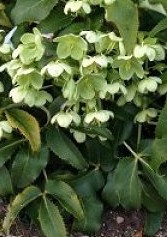 Corsican hellebore is a clump-forming perennial native to Corsica and Sardinia where it grows in a variety of habitats from woodlands to roadsides, streambeds, and exposed mountain tops. It is a member of the buttercup family (Ranunculaceaea) and is one of the largest of the hellebores. The foliage is evergreen and the leaves consist of three leaflets that are blue- to gray-green in color and five to seven inches long with toothed margins. The nodding, cup-shaped flowers are two inches across and have pale-green petal-like sepals. They are carried above the leaves in terminal clusters from late winter to spring. Although Corsican hellebore is less hardy than most other hellebores, it can tolerate more sun. Corsican hellebore is a handsome plant that can assume shrub-size but is short-lived. The genus name comes from the Greek bora meaning food and helein meaning injuries,referring to the poisonous nature of the leaves, stems and roots of the plant if ingested. The specific epithet comes from the Latin argutus meaning sharp and folia meaning leaf, and refers to the toothed margins of the leaflets.
Corsican hellebore is a clump-forming perennial native to Corsica and Sardinia where it grows in a variety of habitats from woodlands to roadsides, streambeds, and exposed mountain tops. It is a member of the buttercup family (Ranunculaceaea) and is one of the largest of the hellebores. The foliage is evergreen and the leaves consist of three leaflets that are blue- to gray-green in color and five to seven inches long with toothed margins. The nodding, cup-shaped flowers are two inches across and have pale-green petal-like sepals. They are carried above the leaves in terminal clusters from late winter to spring. Although Corsican hellebore is less hardy than most other hellebores, it can tolerate more sun. Corsican hellebore is a handsome plant that can assume shrub-size but is short-lived. The genus name comes from the Greek bora meaning food and helein meaning injuries,referring to the poisonous nature of the leaves, stems and roots of the plant if ingested. The specific epithet comes from the Latin argutus meaning sharp and folia meaning leaf, and refers to the toothed margins of the leaflets.
Type: Herbaceous perennial
Bloom: Pale green nodding, cup-shaped flowers 2” across in late winter to spring
Size: 1.5-4’ H x 1.5-4’ W
Light: Part to full shade but tolerates full sun if moisture is ample
Soil: Humusy, moderately moist, well-drained; somewhat drought tolerant when established
Hardiness: Zones 6-8
Care: Cut back leaves damaged by cold weather before flowering; cut flowering stems after flowering to promote new leaf growth
Pests and Diseases: Black spot
Propagation: Seed
Companion plants: Eleagnus x ebbingei ‘Gilt Edge’, Cornus alba ‘Sibirica’, Cotoneaster horizontalis, white Japanese anemone hybrid, Lilium regale, Polygonatum x hybrid, Anemone coronaria, Euphorbia characiasin, Euphrobia x martinii
Outstanding Selection: ‘Janet Starnes’ (Mottled leaves)